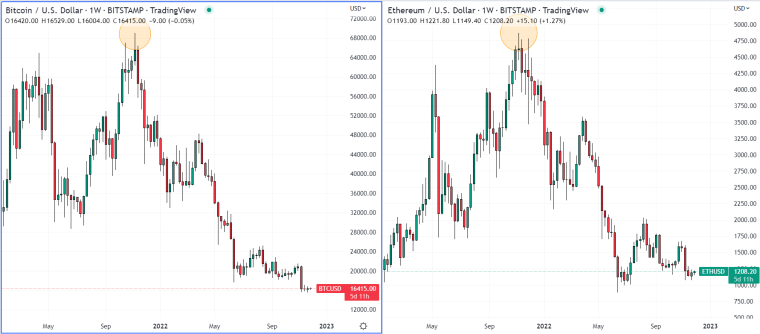2022 has been an ugly year for crypto. Crypto markets soured in late 2020/2021 as major central banks across the world axed interest rates to zero (or lower) and implemented massive quantitative easing programs, and as governments printed massive sums of money via huge fiscal deficits to fund pandemic-related relief programs.
Having dipped as low as $108 billion in early 2020, the total market capitalization of cryptocurrency markets had shot as high as $3 trillion by late 2021. Bitcoin hit $69,000 and ethereum exceeded $4,800.

But the party could never last. All the stimulative excess dished out by monetary and fiscal policymakers in 2020 and early 2021 quickly came back to bite in the form of inflation. By mid-2021, Consumer Price Inflation (CPI) rates in most major developed economies were running way above central bank targets.
Central banks remained in denial for a while, thinking that inflation would just be transitory and that they would be able to press ahead with their zero-interest-rate policies. But by the end of 2021, when inflation had failed to abate, reality set in.
By early 2022 it had become obvious what was coming – significant interest rate hikes and quantitative tightening. In other words, a massive reversal on all the stimulative excess that had helped pump crypto markets so hard in 2020/2021.
Naturally, as central banks have aggressively raised interest rates this year and as the outlook for global growth has taken a turn for the worse, sentiment in not just cryptocurrencies but also traditional risk assets, has taken a drastic turn for the worse.
2022’s Crypto Winter Could Worsen If These Things Happen
As of late November 2022, a little over a year since bitcoin and ethereum posted their record highs, the former is changing hands in the mid-$16,000s, and the latter near-$1,200. That represents respective drawdowns of around 75%. Cryptocurrency markets are currently in the throws of what many refer to as a “crypto winter”.
Lower prices mean job cuts across the industry, less funding for new projects, and massive deleveraging. Dozens of cryptocurrency lending/trading platforms and exchanges have imploded, after finding themselves on the wrong side of over-leveraged positions.
Indeed, the spectacular and abrupt implosion of cryptocurrency exchange FTX earlier this month was the key catalyst behind the latest 25% drop in bitcoin’s price. FTX had formerly ranked as one of the largest exchanges in the world.
FTX’s demise has dragged firms like BlockFi and Genesis with it. The former declared bankruptcy earlier this week, and the latter may soon follow. Traders fear that further so-called “contagion” within the crypto industry could yet drag crypto prices lower.
If FTX was misappropriating user funds, could other major centralized players in the space like Binance or Tether be doing the same thing? Dogecoin founder Billy Markus warned in a now-deleted tweet earlier this month that, if either of these two companies were to collapse, “its pretty much game over” for crypto.
Alternatively, further cryptocurrency downside could come from the macro side of the equation. As noted above, aggressive monetary policy tightening in 2022 to tame an unexpected surge in global price pressures has been a key driver of the 2022 bear market.
Well, what if this trend isn’t over yet? US inflation has peaked, with the annual rate of headline CPI back under 8% after rising above 9% earlier this year. But that is still way above the US Federal Reserve’s 2% target. At the moment, Fed interest rate futures are priced for the Fed to lift rates to about 5% by the first half of 2022.
But will this be enough to get inflation back to 2%? If US inflation remains stickier than expected, which is not an unreasonable assumption given the ongoing strength of the US labor market, which has defied all expectations this year, we could soon be talking about the Fed lifting interest rates above 6%.
That would likely batter cryptocurrency prices. In this scenario, bitcoin could be looking at a test of $10,000. Ethereum would almost certainly be headed back under $1,000.
Catalysts For a Giant Upturn
Luckily for major cryptocurrencies like bitcoin and ethereum, macroeconomic conditions and the fate of major centralized crypto industry players likely won’t be a major driver of their prices in the long term.
Amongst the general population, understanding of crypto remains low. Those with only a surface-level understanding of the space might conflate FTX and bitcoin. But to those in the know, the two couldn’t be more different. Bitcoin is a decentralized, fully transparent payment application. FTX was a centralized, opaque exchange that more than anything resembled something you would typically see in traditional finance.
While weaker global macro fundamentals do dent the near-term demand for crypto, the global trend remains strongly in favor of the continued adoption of the technology. Developers continue to build user-friendly applications of the technology at breakneck speed. According to a study published by the Boston Consulting Group (BCG) earlier this year, the number of global crypto users could hit 1 billion by 2030.
It’s hard to make long-term bets against coins like bitcoin and ethereum, which will almost certainly remain dominant cryptocurrencies when the outlook for the adoption of cryptocurrency technology looks so strong.
With macroeconomic conditions expected to improve in 2023 and with the ongoing crypto deleveraging cycle likely to end at some, focus should eventually return to the strong underlying fundamentals of major blockchains like the bitcoin and ethereum networks. Many remain confident that bitcoin will hit $100,000 in the coming years and ethereum $10,000 by the end of the decade.
IMPT - New Eco Friendly Crypto
- Carbon Offsetting Crypto & NFT Project
- Industry Partnerships, Public Team
- Listed on LBank, Uniswap
- Upcoming Listings - Bitmart Dec 28, Gate.io Jan 1st